If you’re thinking about adding some plants to your home decor, consider choosing kinds that will improve your health. All plants convert carbon dioxide to oxygen through photosynthesis, which helps purify the air. However, some species do it quicker than others or remove specific toxins that others won’t filter out. Keep reading to learn which houseplants are best for improving your health and purifying your air.

Do Houseplants Really Help?
In 1989, NASA conducted a study on houseplants and their effect on air quality. The study included over 15 plant species that are kept as typical houseplants. They studied the plant’s effects on the levels of benzene, trichloroethylene, and formaldehyde in the air. Interestingly enough, different species of plants removed one chemical better than others.
For example, mass cane removed 70% of the formaldehyde in the controlled chamber, but only 21.4% of the benzene. On the other hand, gerbera daisy only removed 50% of the formaldehyde but 67.7% of the benzene. The good news is that all of the plants removed some of each chemical. Having a versatile selection of houseplants is a great way to keep your air pure and improve your health.
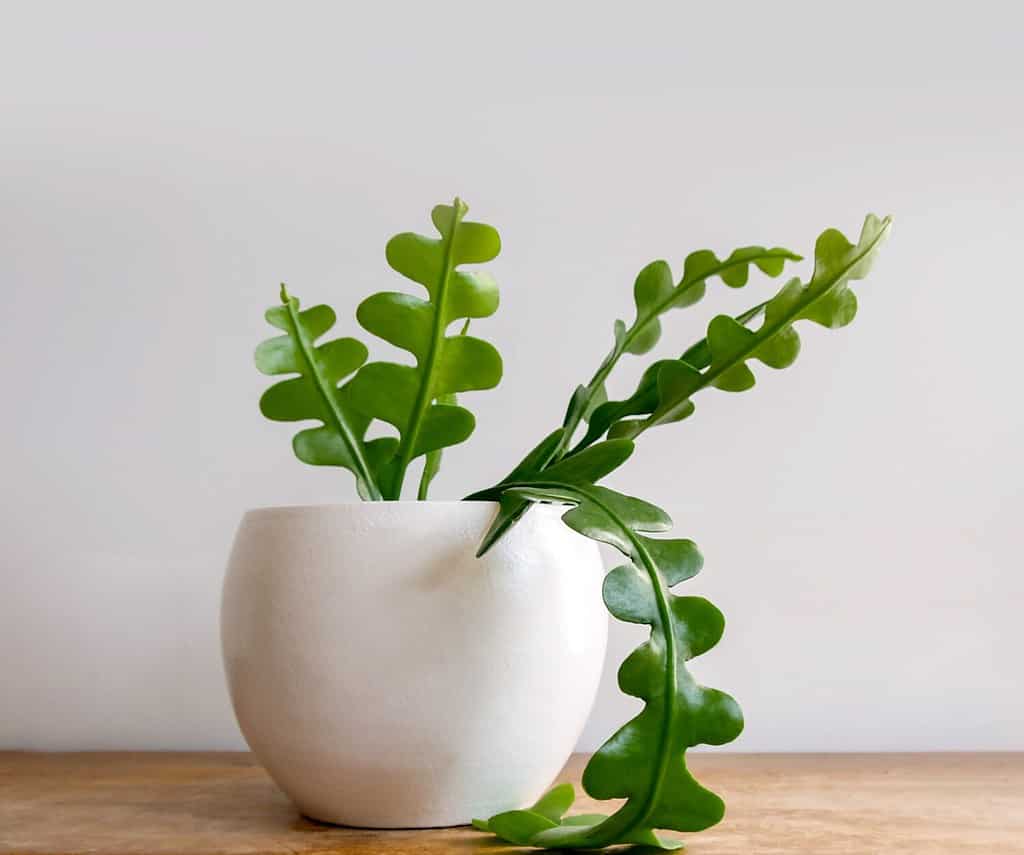
Houseplants are effective at cleansing the air and removing different chemicals.
©Kulbir G/Shutterstock.com
1. Mass Cane
If it’s good enough for NASA, it’s definitely worth the first spot on our list. The study referenced above showed that mass cane was great for removing formaldehyde from the air. It also removed a smaller percentage of benzene and trichloroethylene.
Mass cane, or Dracaena fragrans, is also called “corn plant”. It looks similar to a miniature palm tree because of its thick, stalky stems and curved leaves coming out of the top. The leaves are green with light yellow or green stripes running down the middle. It makes a great addition to any home because it requires little maintenance and offers great benefits. Mass cane can also produce sweet-smelling white flowers, which only happens rarely. These plants reach 4 to 6 feet tall and grow best next to a window with filtered sunlight.
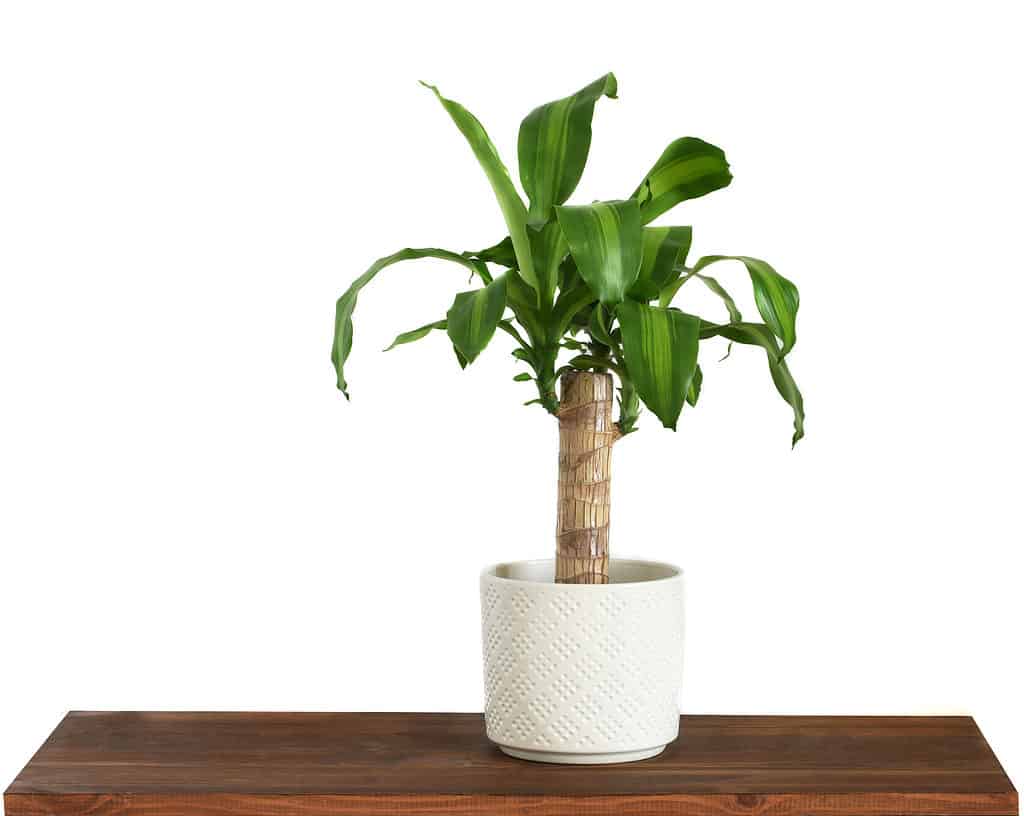
s look like miniature palm trees.
©Sachiczko/Shutterstock.com
2. Chrysanthemum
Chrysanthemum, also known as Chrysanthemum morifolium, scored the most consistently high ratings in the NASA study. This plant removed 61% of formaldehyde, 53% of benzene, and 41.2% of trichloroethylene. Out of the results gathered, this made chrysanthemums the most versatile houseplant for removing air chemicals.
On top of being great for improving your health through air quality, their bright colors will lift your spirits. Chrysanthemums are a great choice for indoor flowering plants because they come in multiple colors and are easy to grow. They need as much direct sunlight as possible, so place them in a large window. It’s also key to water them regularly anytime the topsoil feels dry.

Water chrysanthemum plants whenever the topsoil feels dry.
©Savina Nataliia/Shutterstock.com
3. Gerbera Daisy
The gerbera daisy, also known as Gerbera jemesonii, is a plant in the same family as sunflowers. They are best known for their bright, vibrant flowers which can be pink, yellow, orange, or white as well as many shades in between. They originate from South Africa and grow well both indoors and outdoors.
One thing to keep in mind with these flowering plants is that they’re susceptible to fungal diseases, including crown rot. Water gerbera daisies in the morning to allow their leaves and roots to dry out over the course of the day. They should be placed in an area with high light and in a pot much larger than the plant to provide adequate space.
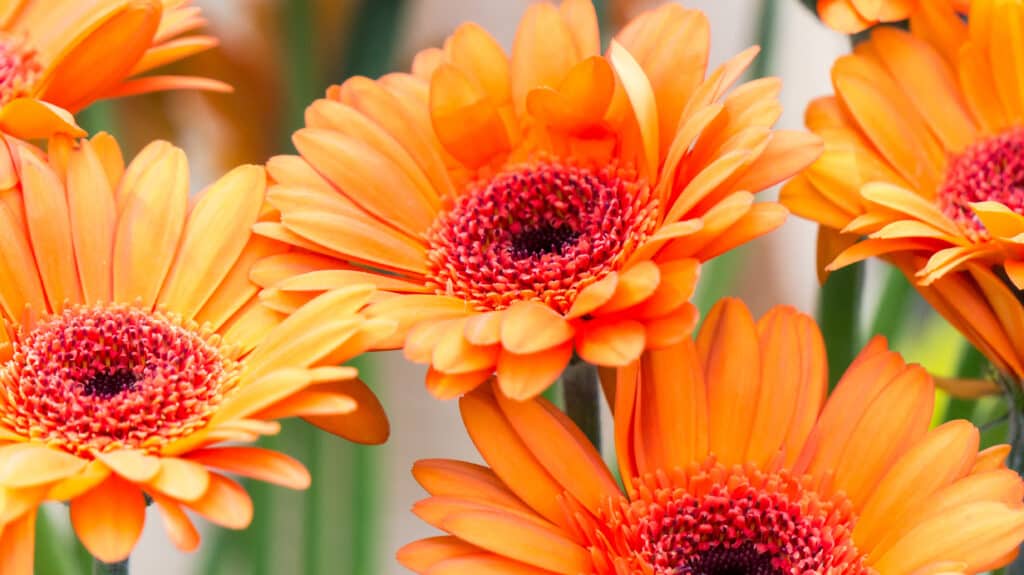
Gerbera daisies come in many vibrant colors like orange and yellow.
©Andrey Shepetov/Shutterstock.com
4. Warneckii
Warneckii, also called the spider plant, is another hybrid variety of the Dracaena fragrans plant, like mass cane. It originated from Africa but has become a popular choice as a houseplant. In the NASA study of indoor air pollution abatement, warneckii removed half of the formaldehyde and benzene from the air.
It’s a gorgeous plant for homes because it goes well with any decor and it’s very easy to grow. They have long green leaves with yellow or white stripes that run around the edges. Warneckii can grow up to five feet tall indoors and can live for up to 40 years. This plant is a great long-term investment that will provide fresh air for your home for years to come.
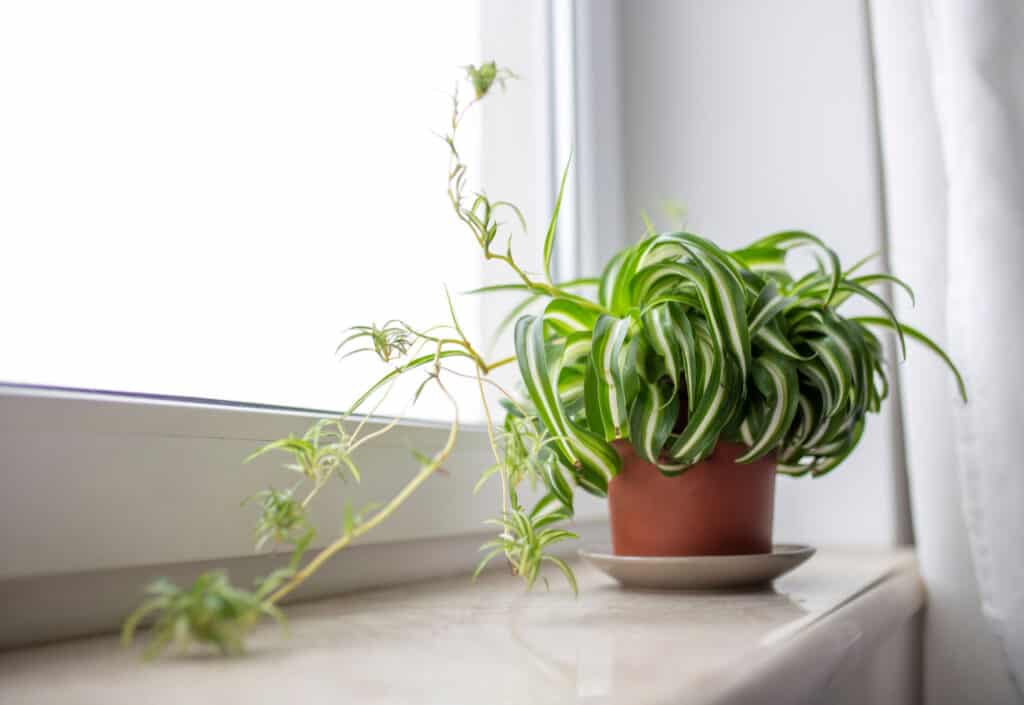
Spider plants have long green leaves with yellow or white stripes.
©ArtCreationsDesignPhoto/Shutterstock.com
5. Ficus
The ficus species includes many different plants that range in size and shape. All plants share the same quality of keeping the air clean. You may also know these plants as fig plants because many varieties also produce edible fruits. However, when grown as houseplants they are rarely able to produce blooms or fruit.
Ficus plants can be more of a challenge when grown as a houseplant, mainly because they are susceptible to overwatering. Water them only when the top 2 inches of soil is dry and make sure the pot has adequate drainage holes. Ficus plants thrive in indirect bright light, so place them near a window but out of direct sunlight.
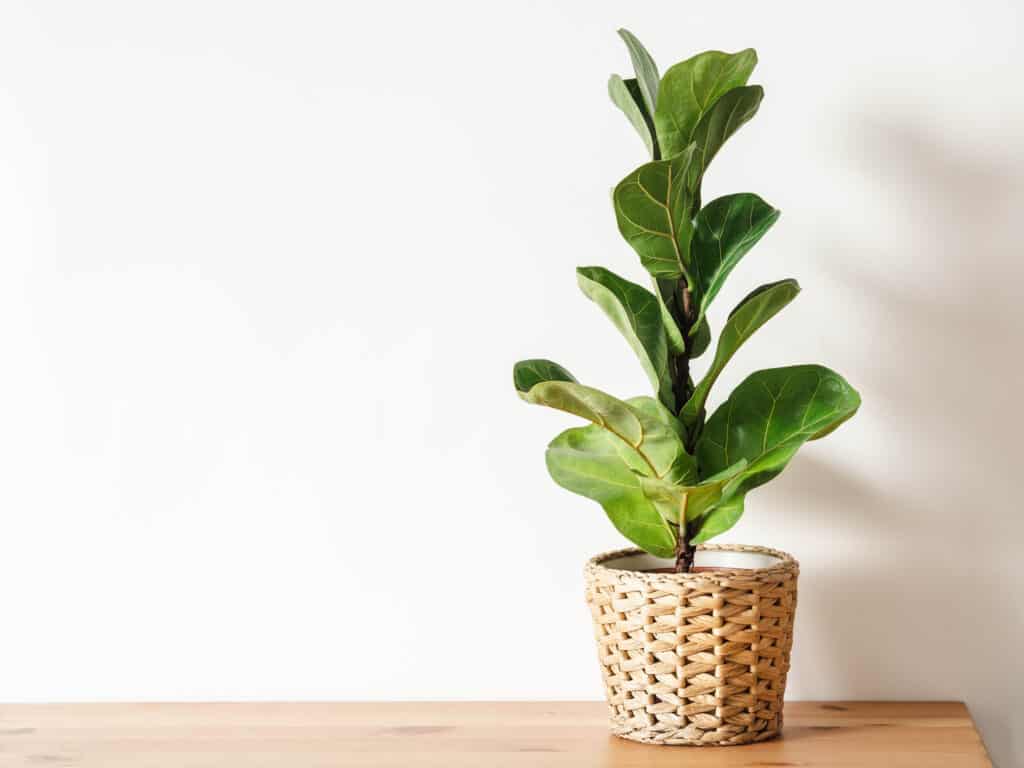
There are many plants within the ficus species, including the popular fiddle leaf fig.
©iStock.com/Olga Peshkova
6. Philodendrons
One of the most popular choices of houseplants is philodendrons. They are effective air cleansers due to their large, heart-shaped leaves. Philodendrons are particularly beneficial in cleansing formaldehyde from the air.
They are so widely loved because of how easy they are to grow. Philodendrons are almost impossible to kill and can go weeks without being watered. In fact, the main worry with this species is overwatering. They are also extremely easy to propagate. Cutting a few small pieces off of the end of your philodendron and placing them in a cup of water or directly into the soil will produce roots in just a few days.

There are many varieties of philodendron plants, ranging in color from dark green to yellow-white, and variegated colors in between.
©iStock.com/Bilal photos
7. Snake Plant
The snake plant, also called Mother-In-Law’s Tongue has risen in popularity as a houseplant. Grown outdoors, they spread rapidly and will take over gardens and green areas. Indoors, they grow extremely well in pots and require very little care. Weekly watering and a bit of window light are all they need to thrive indoors well.
Snake plants are often placed in bedrooms and bathrooms because of their quick air-cleaning qualities. They are quite decorative, with long, slender green leaves that have jagged dark green stripes running vertically across. Snake plants make a great addition to households because they are easy to grow. They are also very easy to propagate. You can take a piece of a leaf, cut it at the base, and let it dry for a day or two. Then place the cutting in soil, where it should develop roots in a few weeks. After this, it will continue growing and produce more leaves as its’ root system develops.
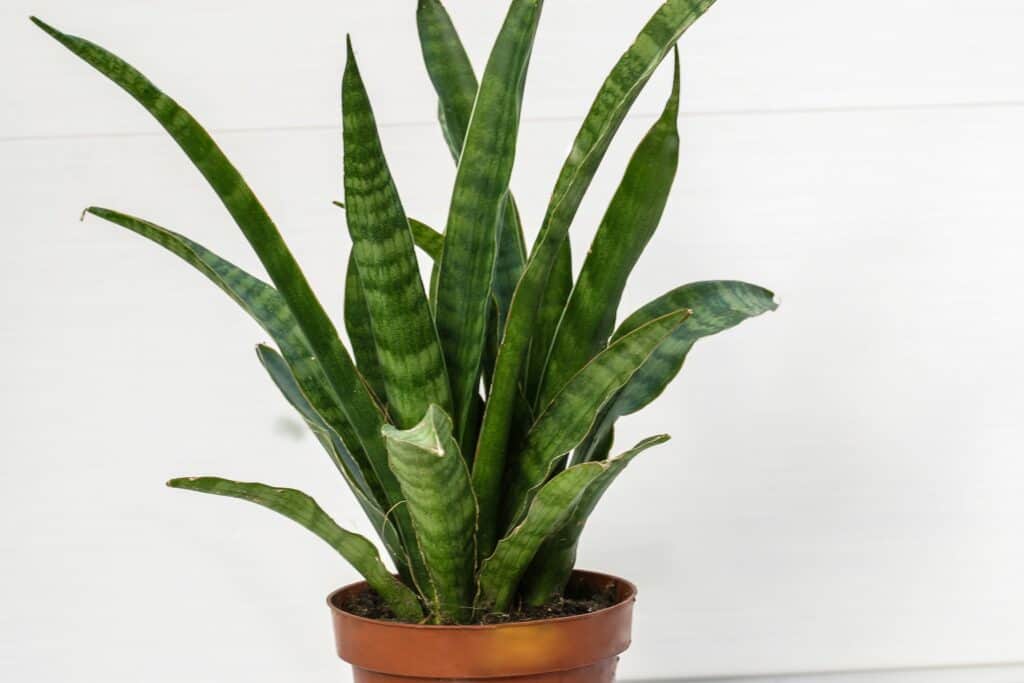
Snake plants are quite decorative, with long, slender green leaves that have jagged dark green stripes running vertically across.
©Olena758/Shutterstock.com
Other Health Benefits of Houseplants
There’s more to houseplants than just their air-cleansing qualities. Studies have shown that having greenery around has a positive effect on mood and provides stress relief. There is an evolutionary connection that humans have with nature, and being in it just makes us feel good. It can also be a subconscious reminder of our childhood, especially if it was spent outside and playing amongst the greenery. Whatever the reason, it’s clear that there is a connection between having plants around and positive mental health.
Healthy for Pets?
Many of the plants on this list, including mass cane, chrysanthemum, warneckii, ficus, snake plants, and philodendrons are all relatively toxic to dogs and cats. Though none of the varieties are usually fatal, they can cause irritation and upset stomach if ingested. Gerbera daisies are non-toxic for cats and dogs, so they are a great choice if you have animals who like to chew. Most of the time pets won’t bother houseplants, especially if they are placed out of reach. However, if you choose to incorporate some of these air-cleansing plants, keep in mind that they should be kept away from pets if possible.

Keep your houseplants, especially toxic ones, as far out of reach as possible from pets and children.
©BONDART PHOTOGRAPHY/Shutterstock.com
Summary of 7 Houseplants That Can Improve Your Health
| Houseplant | Health Benefits | |
|---|---|---|
| 1 | Mass Cane | Great for removing formaldehyde from the air |
| 2 | Chrysanthemum | Removes 61% of formaldehyde, 53% of benzene, and 41.2% of trichloroethylene from the air |
| 3 | Gerbera Daisy | Has purifying properties |
| 4 | Warneckii | Removes half of formaldehyde and benzene from the air |
| 5 | Ficus | Has air cleaning properties |
| 6 | Philodendrons | Beneficial in cleansing formaldehyde from the air |
| 7 | Snake Plant | Has air cleaning properties |
The photo featured at the top of this post is © Ilina Yuliia/Shutterstock.com
Thank you for reading! Have some feedback for us? Contact the AZ Animals editorial team.







